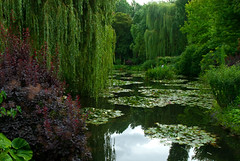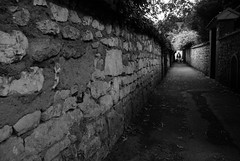If camera bodies and bags are the number 1 and 2 dork shopping obsessions related to photography, sharpness is probably a close third. It is probably the most popular purely technical aspect of actual pictures that makes it to the camera dork shopping list. People buy bigger cameras, more expensive lenses, sturdier enlargers (well, maybe not), and spill a lot of sweat and tears over sharpness and “picture quality.” Even my resolutely un-camera-dorky partner peterb got into the act when he described the Nikon D300 autofocus system as being one that could lead to “tack sharp” images. Unfortunately, it’s a hard concept to pin down. Most people will tell you when they think a picture is sharp, or not. But sharpness is more of a mixture of multiple technical characteristics than a single measurable quantity.
I would be on shaky ground if I tried to present you with a purely technical discussion of what makes pictures look sharp. I don’t have the background in optics or the various engineering fields necessary to talk about the subject at that level. But in my experience in taking photographs, I do know that there are a collection of factors that you, the photographer can control, that lead to a general impression of sharpness, or not. I will list these here for your reference.
Focus
Every picture as a point of best focus. When you are good, and sometimes when you are lucky, you manage to put the most important part of your subject at the point of best focus in the picture. This makes the picture look sharper.
Depth of Field
As you move away from the point of best focus things get progressively blurrier. The concept of depth of field refers to how far to the front or back of the focus point you can be and still “appear” sharp. Depth of field is a function of the focal length of the lens, the focus distance, and the aperture that you are using. These are all numbers can you can read off. But, depth of field is also a function of how blurry you are willing to allow the picture to be. This last parameter is called the “circle of confusion”, and all the DOF charts or graphs all depend on first fixing how large you allow this circle to be.
Generally you get more depth of field by taking pictures of things that are far away with short focal length lenses at small apertures like F8 or F11. Of course, things that are far away are often tiny and boring and you can’t shoot everything with a short lens. Also, stopping down too much can introduce diffraction and other problems. In addition, having too much depth of field can cause its own issues, as anyone who has found herself in a photograph with a telephone pole growing out the side of her head can attest. So, working with depth of field, like everything in photography, is an exercise in compromise.
Image Size
The more you magnify a picture the more blurry it looks. I think this fact alone would discourage people from having absolute discussions of sharpness, but it doesn’t. I have a modest example. I took this picture in France, and it looks great at flickr sizes:
.
When you print it 12×18 and stare at it, you realize that I didn’t put the focus where I should have and the right half of the shot is mostly out of focus. So is the picture sharp? Yes and no. There is no single answer.
These days with digital cameras, people tend to hold their pictures to a ludicrous standard in terms of sharpness versus image size. You open the file up in Photoshop and crank it up to 100% and proclaim that your camera can’t focus, your lenses are crap and you botched the depth of field yet again. Never mind that you’d have to print the shot at 60 by 40 inches to really notice. Don’t be that guy. At this point I will note that I’m the only one I know who is bothered by the focus problems in the above picture from France.
Subject Motion
Aside from focus problems this is probably the number one reason pictures don’t look sharp. If what you are taking a picture of moves while the shutter is open, it will be blurry. The solution is to either nail the thing in place or use a faster shutter speed. Probably half of all example images proclaiming that a camera or lens doesn’t work are actually unsharp because of subject motion.
Camera Motion
The flip side of subject motion is camera motion. If your camera shakes up and down while the shutter is open then it’s just like your subject is jumping up and down in front of you while the shutter is open. What you get in the end is a blurry picture. Probably half of all example images proclaiming that a camera or lens doesn’t work are actually unsharp because of camera motion.
Sometimes it’s fun to play around with using subject and camera motion on purpose… but it usually doesn’t work:
Subject Texture
Here is an intersting wrinkle. Some subjects just look sharper than others. Rocks look sharp:
Water and fog and mist, not so much:
Filling your pictures with things that have a lot of fine detail or clear sharp edges tends to make people think they are sharper. One of the reasons for this is the special importance of edges in the psychology of perceived sharpness. Edge sharpness is so important that the most used filter in Photoshop is the so called unsharp mask which, in its simplest form, is nothing more than a computation that increases contrast around the edges to make them look sharper.
Lighting
Another often overlooked aspect of sharper pictures is the lighting. In general directional light that emphasizes textures and edges makes pictures seem sharper. Also, juxtaposing high contrast light against low contrast light is a good way to make your subject “pop” out of the picture. Head over to the Strobist for more lessons about this. The principles are the same for either flash or natural light. Here is a lame example:
If you want your pictures to look flat and boring and completely lacking in texture, find light that is head on and very uniform:
Flat light from the front makes it impossible to find the edges in the picture, and sharp looking edges are psychologically important.
Resolution
I put this last because out of all of the factors I have listed it probably has the least to do with perceived sharpness. Resolution is nothing but a measure of the smallest detail that your imaging system can show as an independent entity in a picture. It can effect sharpness in that if you are taking a picture of something with a lot of fine detail, that detail will look sharper if it is better resolved. But there are plenty of pictures that are relatively low resolution that look sharp anyway. The best examples are HD television and projected films, both of which we think of as sharp even though the raw resolution is pretty low. Very small but sharp looking web photos are another example.
I think the rise of digital cameras have made people overly conscious of resolution and they tend to latch on to it in the hope of finding a single number that means “good image quality.” I think history will show that hardly anyone needs more than a few megapixels, and of those people, hardly any really needed more than six.
Related to resolution, you will also notice that I didn’t mention anything about lenses. I don’t have much to say about lenses for two reasons. First, I think the other aspects of image sharpness are more important than the raw performance of the lens. Second, I have never felt that I am “lens limited” with respect to how my pictures look. If there is something wrong with them, there is almost always something else to blame, and it’s usually my technique. If I were a real photographer, I would feel more confident about proclaiming grand truths about lenses. But as it is, the reality is that all the lenses you can buy are probably good enough. And if they are not, you’ll probably find out before me.
To sum up, in order to take sharper pictures you should:
1. Find sharper subject matter.
2. Keep the subject still or your camera still or both.
3. Use good light.
4. Learn to focus.
Seems simple enough. Maybe I’ll figure it out in another 20,000 pictures.











I would recommend at least a cursory glance through Merklinger’s “The Ins and Outs of Focus”, which is out of print now but available as donationware here: http://www.trenholm.org/hmmerk/download.html
He goes into a lot of the technical stuff on lenses etc, but only so much to justify a couple of simple rules of thumb.
The most useful stuff I found was on how the circle of confusion (or disc of confusion in the subject space) varies on either side of the depth at which things are focussed. The most useful take-home is that a disc of confusion of a given size (say 1/4″ in the real world) is going to make way more difference on the near side of your focal plane than the far side, i.e., 1/4″ blur on someone’s face that is close to you is going to be more “obviously fuzzy” than 1/4″ blur on something 20′ away. So err on focussing the foreground if you actually want the whole image to look relatively sharp. Unless of course there is a telephone pole and a head. And the hyperfocal distance stuff I think sets a maximum bound on the amount of blur at infinity (disc of confusion upper size bounded by the front element size of your lens) if I remember correctly.
Anyway it’s worth nerding out over for an evening and then you can promptly forget most of it and stick to the rules of thumb which you summarized above: resolution doesn’t matter, final image size does.